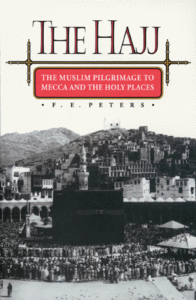
Francis Edward Peters (F.E. Peters) is Professor Emeritus of History, Religion and Middle Eastern and Islamic Studies at New York University (NYU) and he has written a great review of the Haj through the ages, from its pre-Islamic beginnings to the way it was in 1926. He ends the book in 1926, so the current hugely enlarged, incredibly safer, more convenient, and in may ways, totally transformed Haj is not covered in this book.
The most intetesting part of the book for me was the first; the discussion of what pre-Islamic Haj looked like and how its rituals were modified (and combined with another pre-Islamic pilgrimage, the Umrah) to creat the current Islamic Haj. This is also the most frustrating section of the book, but that is not FE Peter’s fault. We just do not have a lot information about what happened before Islam. Pagan Arabia was completely converted to Islam within one generation, and the attitude of the new religion towards the past was generally negative and dismissive. A mostly illiterate culture, it has left us with almost nothing except a few poems (preserved, ironically, because the later interpreters of the Quran felt that their language could help unlock the meaning of words and phrases in the Quran that these later generations had difficulty understanding) and whatever (generally negative and dismissive) references survive in Islamist historiography. Of course, we can learn some things from the Quran itself, but these frequently tend to be in the form of “answers without a question”, which must have been completely transparent to the first generation, but whose meaning required some explanation and interpretation by later generations. Most of this is supplied by the exegetical and historical works written in the next 2-400 years, but it can be impossible to separate fact from posthoc mythmaking. Anyway, this is what we have, and FE Peters makes a heroic effort to sift through it to find what can still be found.
For example, we know that the main pre-Islamic Haj rituals took part in Arafat and Mina (with major trade fairs at both locations) and the Quresh had little (possibly nothing) to do with the management of that Haj. The rituals within Mecca were more associated with the distinct pilgrimage of Umrah (e.g. the tawaf around the Kaaba). The running between Safa and Marwah was connected to all this, but not necessarily as part of the same pilgrimage (there is some evidence that the most “fundamentalist” of the Quresh did not regard it as permissible to take part in that running, even though it is literally a stone’s throw from the kaaba). There is a verse in the Quran that tells Muslims that it is in fact permissible to do this running, so clearly some question had been raised about it, but what that question was is no longer known to us.
In those days, the pre-Islamic Arab calendar included intercalation, so it maintained its connection with the seasons. Because of this, the Haj and the Umrah were two distinct seasonal festivals: the Haj in the spring, and the Umrah in the fall. But Islam combined certain aspects of Haj with some from the Umrah and created one pilgrimage, that then that lost its connection with the seasons (because Islam abandoned the intercalation that “corrected” the lunar calendar to keep it in sync with the solar cycle).
Muslims have introduced detailed myths that connect all aspects of Haj with Abraham and Ismail, but it is not clear what, if any, connection the pagan Haj used to associate with Abraham. The later doctors of Islam found (or invented) multiple Abrahamic explanations for some (but not all) the rituals that constitute the Hajj, but until we find some other corroborative evidence (unlikely at this point) this remains mostly a matter of faith. Anyway, Hubal (or rather, an idol of Hubal, imported from Babylon?) used to sit in the Kaaba with 7 divining arrows, while the statues of Asaf and Naila (supposedly two lovers who copulated in the Kaaba and were turned into stone for that reason) stood on the hills of Safa and Marwah. There were trade fairs in Arafat and in Mina and sacrifices were offered in Mina and very likely in (or in front of) the Kaaba itself.
The Kaaba, the focal point of it all, is frequently referred to as a cube (the word in fact means “cube”) and it was apparently a part of pagan Arabian religious ritual, there being several other Kaabas in pre-Islamic Arabia, though this one may have been the first and most famous. It was not roofed at some point in pre-Islamic times, but then someone went over the wall and stole the temple treasure stored within it, so a roof was added. It was in a precarious state of repair when, around 600 AD, the Quresh had a stroke of luck when a shipwreck made timber available and a Coptic carpenter supplied the necessary skill, allowing them to rebuild it. Their dimensions are the ones used in the current incarnation and somewhat surprisingly, with these dimensions it is not really a cube. It is 40 by 35 by 50 feet, and it its corners, not its sides are oriented to the cardinal directions. It is clearly ancient (whether as ancient as Abraham is a matter more of faith than of history; historians and archaeologists have little to go on in this matter) but its association with the head god Allah seems to be ancient. When the pagan Arabs came for Haj, they chanted a talabiya (a chant we still use) that was very similar to the current Muslim version, but it differed in saying that other Gods may intercess with Allah, though only with his permission. The Islamic version removed that line and added firm and clear statements that there is only one God and he has no peers. It would be fascinating to learn more about the origins and development of these ritual before Islam, and their transformation by Islam, but unfortunately we have little to go on and little chance of learning something new because archaeological investigation is obviously out of the question.
This Kaaba was damaged in the first siege of Mecca by the Ummayads and was then rebuilt by the alt-caliph Abdullah bin Zubayr. Relying on a hadith that stated that if it was up to him, Mohammed would have liked to restore the building to its original dimensions (it had apparently been shortened by the Quresh when THEY rebuilt it in around 600 AD) ibn Zubayr enlarged it to its original dimensions and created ground-level doors on both sides. According to eye-witnesses of this effort, when they dug down to the foundations, they discovered that the oldest foundation consisted of inter-twined green stones; and that the famous hajr-e-aswad (the black rock at the corner of the building that is still the most venerated stone in Islamdom) is white or rosy-white in the back, shaped somewhat like the roots of a molar tooth, while its exposed front surface is smooth and black (due to the constant kisses of sinful pilgrims). Since the first fire (started by Husayn ibn Numayr’s shelling of the kaba during the first Ummayad siege) had damaged the black stone and cracked it into three parts, these were held together by silver nails (there was a further breaking up of the stone when the Qaramatyans raided Mecca and stole the black stone for a while).
Anyway, Ibn Zubair’s achievement was short lived as the Ummayads now sent the far more capable and ruthless Hajjaj Bin Yusuf against him, and this time the Kaba was almost completely knocked down by Hajjaj’s use of a catapult against Ibn Zubair and his band of brave followers. After killing and beheading Ibn Zubayr (about whom Hajaj’s own general said that “women have given birth to none braver than he”), Hajjaj rebuilt the kaba back to its Qureshi dimensions, which are the dimensions we have today. He also closed the second door and raised the one door about 7 feet above ground level so that riff-raff cannot get in and entry to the interior is carefully controlled (there is nothing especially holy about the inside, unlike the “holy of holies” of the Jewish temple, it is not especially restricted in a religious sense, entry is just controlled because otherwise the crowds would unmanageable).
The rest of the book deals with accounts of the Haj in medieval and then in Turkish times (the Ottomans controlled the Hijaz region with one or two short interregnums, for about 300 years). The accounts of various European travelers are mentioned in some detail along with the accounts of various famous Muslim pilgrims. The dominant thread is one of of the dangers and hardships of the pre-modern Haj; menaced by Bedouin tribes who looted or extorted pilgrims on the way, by the danger of starvation or dying of thirst, the lack of the most elementary facilities once you got to Mecca, extortion by various caretakers, like the Zamzamis who controlled the well of Zam Zam and the water that came from it, the epidemics that struck with regularity, and so on.
Things changed dramatically once the Saudis conquered Hijaz in the 1920s and especially after oil money allowed them to greatly enlarge and improve every aspect of the pilgrimage. But even before oil money, the Ibn Saud took their custodianship very seriously, clamping down on crime and extortion and generally cleaning up the place. Of course, along with countless undeniable improvements, they also cracked down on many rituals and destroyed ancient monuments and buildings in a mania of religious fundamentalism and massive commercialization. You win some, you lose some. Incidentally, one of things lost is the original well of ZamZam. The Saudis have built over it, and now pipe properly filtered water from the same site, draining a now scientifically managed Mecca aquifer for everyone, based on the sound hydrological basis that the well was itself simply getting water from that very aquifer. But that story is not part of this book. someone else will write that book.
All in all, well worth reading, but a bit dry and scholastic and thin on the pagan side of Haj and on the first 3-400 years after Islam. This is not the authors fault, since the sources are simply not there. There are also a few sets of old photos which are worth a look, especially when compared to the greatly expanded facilities of today.
The pictures here are not from the book. They are from Google, or from my camera.
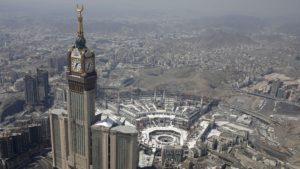
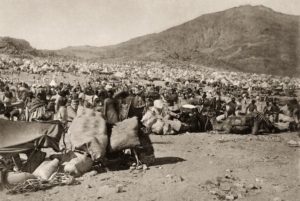
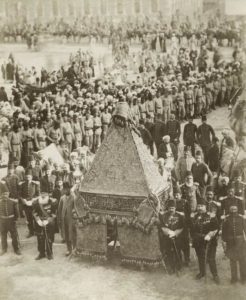
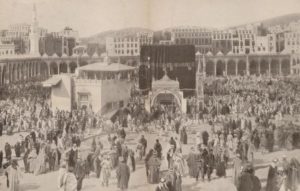
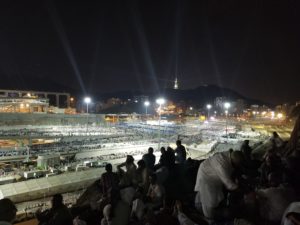
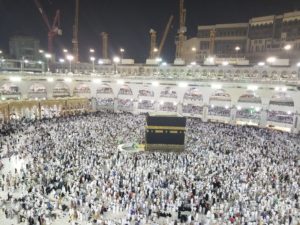
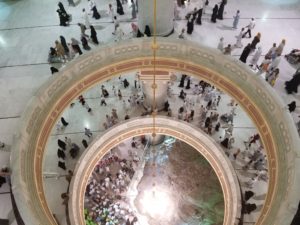
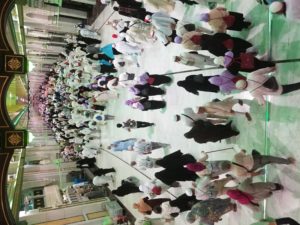
Very interesting and fascinating summary/accounts.That’s my next read.
The most interesting part was of course the sinful pilgrims 🙂
Thanks
// The Kaaba, the focal point of it all, is frequently referred to as a cube (the word in fact means “cube”) //
I wonder if it actually a cognate of “cube”. English “cube” is ultimately from Greek “kybos” (six-faced die) via Latin (“cubus”) and the etymology of “kybos” itself is unknown. This is very probably not IE, as dice figure very prominently in the earliest Vedic canon and also Classical Sanskrit poetry such as the Mahabharata (a game of dice gone wrong started that goddamn war!). The word for a six-faced die (also used in the sense of “cube”) is well known – aksha (HKT /akSa/).
So, that leaves us with a foreign source of Greek “kybos”. Greek generally borrowed a lot of vocabulary from the Canaanite group of NW Semitic languages (members include Phoenician, Hebrew etc) spoken in the Levant and Eastern Mediterranean. So, it is possible that “kybos” itself is a Semitic word, cf. standard Arabic “muka’eb” (cube, die), Hebrew “koobiyeh” (cube, die). Who knows maybe gambling using dice was originally a Semitic invention …